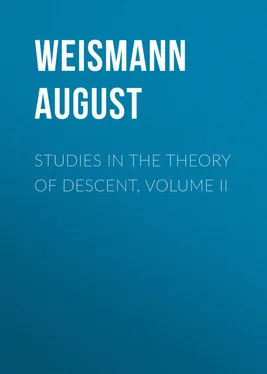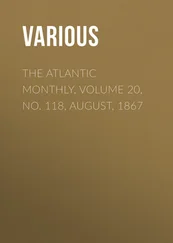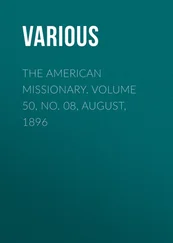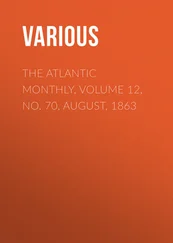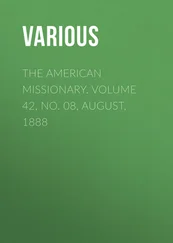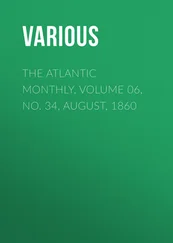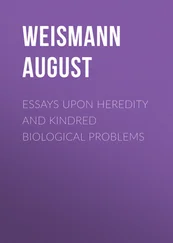August Weismann - Studies in the Theory of Descent, Volume II
Здесь есть возможность читать онлайн «August Weismann - Studies in the Theory of Descent, Volume II» — ознакомительный отрывок электронной книги совершенно бесплатно, а после прочтения отрывка купить полную версию. В некоторых случаях можно слушать аудио, скачать через торрент в формате fb2 и присутствует краткое содержание. Жанр: foreign_antique, foreign_prose, на английском языке. Описание произведения, (предисловие) а так же отзывы посетителей доступны на портале библиотеки ЛибКат.
- Название:Studies in the Theory of Descent, Volume II
- Автор:
- Жанр:
- Год:неизвестен
- ISBN:нет данных
- Рейтинг книги:4 / 5. Голосов: 1
-
Избранное:Добавить в избранное
- Отзывы:
-
Ваша оценка:
- 80
- 1
- 2
- 3
- 4
- 5
Studies in the Theory of Descent, Volume II: краткое содержание, описание и аннотация
Предлагаем к чтению аннотацию, описание, краткое содержание или предисловие (зависит от того, что написал сам автор книги «Studies in the Theory of Descent, Volume II»). Если вы не нашли необходимую информацию о книге — напишите в комментариях, мы постараемся отыскать её.
Studies in the Theory of Descent, Volume II — читать онлайн ознакомительный отрывок
Ниже представлен текст книги, разбитый по страницам. Система сохранения места последней прочитанной страницы, позволяет с удобством читать онлайн бесплатно книгу «Studies in the Theory of Descent, Volume II», без необходимости каждый раз заново искать на чём Вы остановились. Поставьте закладку, и сможете в любой момент перейти на страницу, на которой закончили чтение.
Интервал:
Закладка:
After the genus 90 there are 22 more genera, and these are spineless, at least in the case of the two chief genera, 93, Apatura , and 104, Nymphalis . Of the remainder I know neither figures nor descriptions. 10 10 [The larvæ of the 110th genus, Paphia , Fabr. ( Anæa , Hübn.) are also smoothed-skinned. See Edwards’ figure ( loc. cit. vol. i. Pl. XLVI.) of P. Glycerium . Also C. V. Riley’s “Second Annual Report” on the insects of Missouri, 1870, p. 125. Burmeister figures the larva of a species of Prepona (genus 99) which is smooth ( P. Demophon , loc. cit. Pl. V. Fig. 1). The horns on the head of Apatura , &c., may possibly be a survival from a former spiny condition. R.M.]
In the two genera named the larvæ are provided with two or more spine-like tentacles on the head, and the last segment ends in a fork-like process directed backwards. The body is otherwise smooth, and differs also in form from that of the larvæ of the other Nymphalinæ , being thickest in the middle, and tapering anteriorly and posteriorly; neither is the form cylindrical, but somewhat flattened and slug-shaped. If therefore we were to arrange these butterflies by the larvæ instead of by the imagines, these two genera and their allies would form a distinct family, and could not remain associated with the 90 other Nymphalideous genera.
We have here a case of incongruence ; the imagines of the genera 1–90 and 91–112 are more closely allied than their larvæ.
From still another side there arises a similar disagreement. The larvæ of the genera Apatura and Nymphalis agree very closely in their bodily form and in their forked caudal appendage with the caterpillars of another sub-family of butterflies, the Satyrinæ , whilst their imagines differ chiefly from those of the latter sub-family in the absence of an enlargement of certain veins of the fore-wings, an essential character of the Satyrinæ .
This double disagreement has also been noticed by those systematists who have taken the form of the caterpillar into consideration. Thus, Morris 11 11 “Synopsis of the described Lepidoptera of North America.” Washington, 1862.
attempted to incorporate the genera Apatura and Nymphalis into the family Libytheidæ , placing the latter as transitional from the Nymphalidæ to the Satyridæ . But although the imagines of the genera Apatura , Nymphalis , and Libythea may be most closely related – as I believe they actually are – the larvæ are widely different, being at least as different as are those of Apatura and Nymphalis from the remaining Nymphalinæ .
Now if we could safely raise Apatura and Nymphalis into a distinct family – an arrangement which in the estimation of Staudinger 12 12 “Catalog der Lepidopteren des Europäischen Faunengebietes.” Dresden, 1871.
is correct – and if this were interpolated between the Satyridæ and Nymphalidæ , such an arrangement could only be based on the larval structure, and that of the imagines would thus remain unconsidered, since no other common characters can be found for these two genera than those which they possess in common with the other Nymphalideous genera.
The emperor-butterflies ( Apatura ), by the ocelli of their fore-wings certainly put us somewhat in mind of the Satyrinæ , in which such spots are always present; but this character does not occur in the genus Nymphalis , and is likewise absent in most of the other genera of this group. The genus Apatura shows in addition a most striking similarity in the markings of the wings to the purely Nymphalideous genus Limenitis , and it is therefore placed, by those systematists who leave this genus in the same family, in the closest proximity to Limenitis . This resemblance cannot depend upon mimicry, since not only one or another but all the species of the two genera possess a similar marking; and further, because similarity of marking alone does not constitute mimicry, but a resemblance in colour must also be added. The genus Limenitis actually contains a case of imitation, but in quite another direction; this will be treated of subsequently.
It cannot therefore be well denied that in this case the larvæ show different relationships to the imagines.
If the “natural” system is the expression of the genetic relationship of living forms, the question arises in this and in similar cases as to whether the more credence is to be attached to the larvæ or to the imagines – or, in more scientific phraseology, which of the two inherited classes of characters have been the most distinctly and completely preserved, and which of these, through its form-relationship, admits of the most distinct recognition of the blood-relationship, or, inversely, which has diverged the most widely from the ancestral form? The decision in single instances cannot but be difficult, and appears indeed at first sight impossible; nevertheless this will be arrived at in most cases as soon as the ontogeny of the larvæ, and therewith a portion of the phylogeny of this stage, can be accurately ascertained.
As in the Rhopalocera most of the families show a complete congruence in the form-relationship of the caterpillars and perfect insects, so a similar congruence is also found in the majority of the families belonging to other groups. Thus, the two allied families of the group Sphingina can also be very well characterized by their larvæ; 13 13 This group of moths (“Schwärmer”) is regarded as of very different extents by systematists; when I here comprise under it only the Sphingidæ proper and the Sesiidæ , I by no means ignore the grounds which favour a greater extension of the group; the latter is not rigidly limited. [The affinities of the Sesiidæ ( Ægeriidæ ) are by no means clearly made out: it appears probable that they are not related to the Sphingidæ . See note 160, p. 370. R.M.]
both the Sphingidæ and the Sesiidæ possess throughout a characteristic form of larva.
Of the group Bombycina the family of the Saturniidæ possess thick cylindrical caterpillars, of which the segments are beset with a certain number of knob-like warts. It is true that two genera of this family ( Endromis and Aglia ) are without these characteristic warts, but the imagines of these genera also show extensive and common differences from those of the other genera. A distinct family has in fact already been based on these genera ( Endromidæ , Boisd.). Thus the congruence is not thereby disturbed.
So also the families Liparidæ , Euprepiidæ , and Lithosiidæ appear sharply defined in both forms; and similar families occur likewise under the Noctuina , although in this group the erection of families presents great difficulties owing to the near relationship of the genera, and is always to some extent arbitrary. It is important, however, that it is precisely the transitional families which present intermediate forms both as larvæ and as imagines.
Such an instance is offered by the Acronyctidæ , a family belonging to the group Noctuina . The imagines here show in certain points an approximation to the group Bombycina ; and their larvæ, which are thickly covered with hairs, likewise possess the characteristics of many of the caterpillars of this group. 14 14 [For Mr. A. G. Butler’s observations on the genus Acronycta , see “Trans. Ent. Soc.” 1879, p. 313; and note 68, p. 169, of the present volume. R.M.]
A second illustration is furnished by the family Ophiusidæ , which is still placed by all systematists under the Noctuina , its affinity to the Geometrina , however, being represented by its being located at the end of the Noctuina . The broad wings and narrow bodies of these moths remind us in fact of the appearance of the “geometers;” and the larvæ, like the imagines, show a striking resemblance to those of the Geometrina in the absence of the anterior abdominal legs. For this reason Hübner in his work on caterpillars has termed the species of this family “ Semi-Geometræ .”
Читать дальшеИнтервал:
Закладка:
Похожие книги на «Studies in the Theory of Descent, Volume II»
Представляем Вашему вниманию похожие книги на «Studies in the Theory of Descent, Volume II» списком для выбора. Мы отобрали схожую по названию и смыслу литературу в надежде предоставить читателям больше вариантов отыскать новые, интересные, ещё непрочитанные произведения.
Обсуждение, отзывы о книге «Studies in the Theory of Descent, Volume II» и просто собственные мнения читателей. Оставьте ваши комментарии, напишите, что Вы думаете о произведении, его смысле или главных героях. Укажите что конкретно понравилось, а что нет, и почему Вы так считаете.
